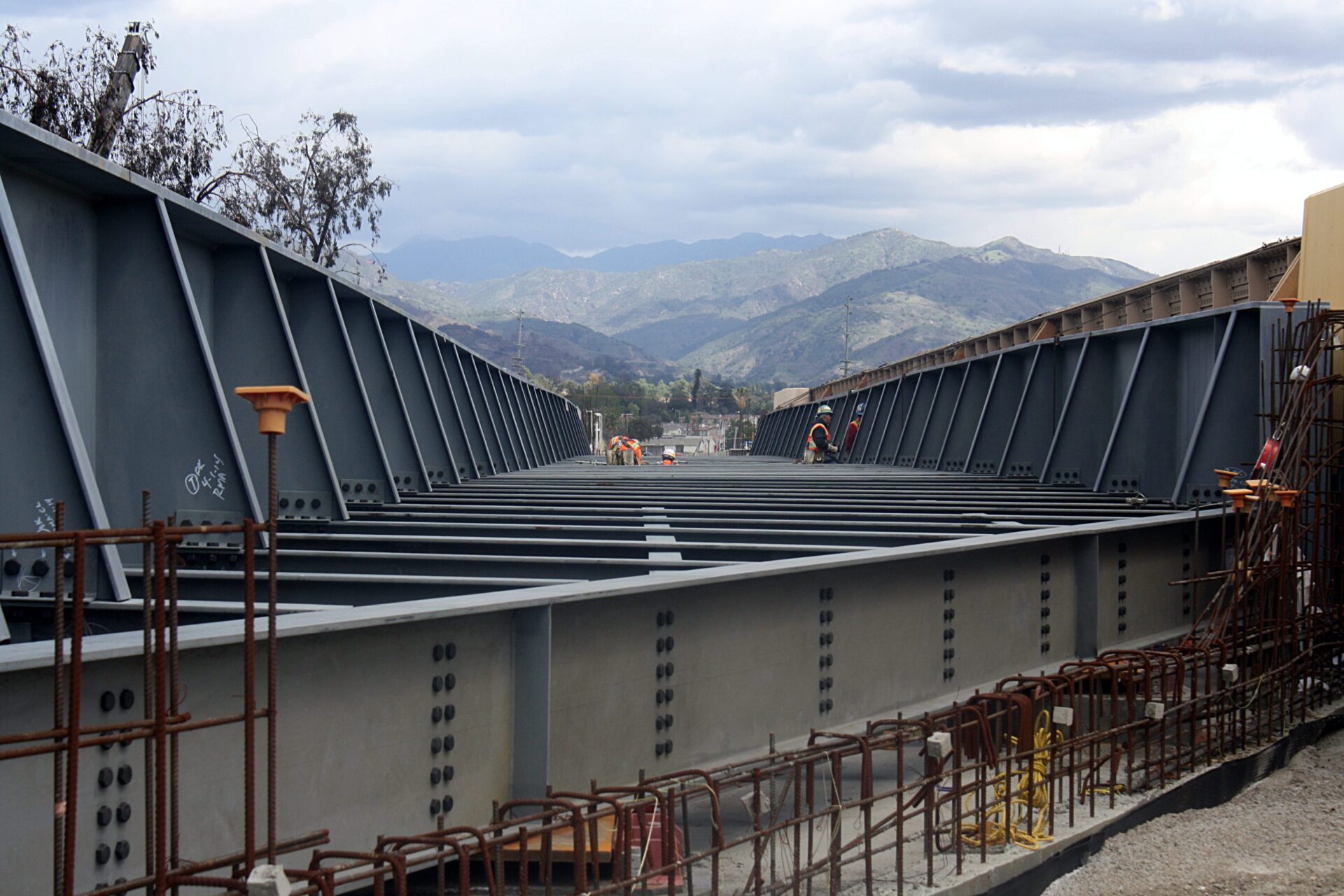

With the passing of the Infrastructure Investment and Jobs Act in early November, Hill International’s U.S. sector leaders took a moment to study the particulars of the funding soon to be available to our public clients. In addition, these Subject Matter Experts suggested ways our clients can make the most of the funding soon to be available. Below, Hill U.S. sector leaders offer some brief observations on the Act and what they expect the long- and short-term ramifications will be on our national infrastructure and how PgM/PM/CM support can help realize the goals of the Act and of our clients.
Rail and Transit
Vice President Mike Radbill, PE, F.ASCE, is Program Manager for Hill’s Project Management Oversight services for the Federal Transit Administration and for Hill’s work on the Monitoring and Technical Assistance Program to Federal Railroad Administration Grants
Combined, the new Infrastructure in Investment and Jobs Act allocates more than $105 billion for transit and freight and passenger rail, with funds targeted for major projects and programs along some the busiest rail corridors in the U.S. as well as for local investments in public transit systems. Without question, the bill will have a lasting impact on how U.S. rail and transit systems are built, operated, and maintained for many years to come.
One of the most intriguing parts of the bill from a rail perspective is Section 22037, which calls for $36 billion to be spent on the Federal-State Partnership for the State of Good Repair program. Now re-named the Federal-State Partnership for Intercity Passenger Rail, the revised program increases eligibility for a variety of project types and selection criteria. Along the Northeast Corridor (NEC) in particular, there is a well-publicized and much-needed backlog of projects and initiatives that the bill will help to address, and I expect the various NEC stakeholders involved will be eager to put these funds to good use. Outside of the NEC and other well-traveled corridors, I think owners who may be less familiar with planning and executing billion-dollar-plus programs and projects will be challenged to get their projects approved through the funding process, and equally challenged to deliver quality projects on time and within budget to make certain they deliver for their passengers and carriers efficiently and effectively. Hill can provide needed assistance to these owners. However, owners who embrace strong monitoring, control, and compliance practices on their projects will enjoy a clear advantage in securing funds, building their new projects within cost and schedule constraints, and serving their customers and communities.
Power & Grid
Vice President Mark Von Leffern, PSP, EVP, PMP, serves as Program Manager for Hill’s multi-billion-dollar professional services contract with one of the largest electric utilities in the U.S. His experience also encompasses renewable energy and electrical infrastructure construction and oil and gas programs and projects.
In terms of number of the number of key programs funded, power projects have more than any other infrastructure sector in the new Infrastructure and Jobs Act. The majority of the bill’s funds for electrical grid projects are focused, rightly I think, on reliability, resiliency, and security. But there are also allocations for several sustainability initiatives, from carbon capture to green energy research. Regardless of whether electricity is generated through traditional, carbon-based fuels or through new, more sustainable sources, the grid has to be there to carry power to customers and communities. The plan will fund the laying of thousands of miles of transmission lines and includes measures to expedite the permitting process to build these lines. For example, grid owners and operators can expect some help for approval for high-priority, regional transmission projects currently held up at the state level, as the language in the bill reinforces the authority of the Federal Energy Regulatory Commission to approve high-priority projects. I think this change in particular will help to speed transmission line projects into construction and strengthen the grid overall.
Resiliency
Vice President, Resiliency and Disaster Recovery Andy Robinson, PMP, specializes in leading resiliency and disaster recovery assignments and served in leadership roles for the Road Home Program following Hurricane Katrina, the New Jersey Housing Program following Superstorm Sandy, and the U.S. Virgin Islands STEP program following Hurricanes Irma and Maria.
In addition to the resiliency requirements applicable to all of the infrastructure sectors in the bill, there is approximately $47 billion specifically allocated to help prepare for and prevent against the impacts of natural disasters. This includes FEMA-administrated programs for flood mitigation and community resiliency, USACE funds for flood protection and river dredging, and cybersecurity and forest service grants. In the wake of disasters like Hurricane Katrina and Superstorm Sandy, we’ve seen that well-considered, well-planned, and well-executed projects can succeed in giving our communities added protection against extreme weather events and rising sea levels. This bill provides agencies and owners with an opportunity to realize resiliency on a regional, and even national, scale when it comes to protecting the power grid, coastal metro areas, and other important infrastructure. The trick now is to prioritize the most critical projects and programs according to risk and need, coordinate with impacted stakeholders to move work forward, and then drive progress to achieve schedule and budget goals. We’ve seen the impacts these disasters have when they strike unprepared communities, and we know climate-related disasters are increasing in both intensity and frequency. This is the time to get to work and make the country safer for everyone.
Broadband
Director, Data Centers Rob Nash-Boulden has more than over 30 years of experience in the data center and mission critical industry with clients such as Amazon, American Express, Digital Realty, Cologix, Cyrus One, eBay, Intel, Internap, LabCorp, Microsoft, SalesForce, Uber, and CREE.
The correlation between broadband access and economic growth, education, health, and a myriad of other factors has been clear for years, and this bill takes steps to make sure America’s rural and low-income communities have the information access most of the country already enjoys. Some of the bill’s funding will go directly to information consumers in the form of help with internet bills, but there is more than $42 billion allocated to state and tribal governments to improve broadband access. The Commerce Department will oversee these funds, with the National Telecommunications and Information Administration responsible for delivering the grants.
What does this mean for cable and telecom providers? Well, considering only 26 states currently even have a broadband office, providers will likely be coordinating with a variety of owners, agencies, and other stakeholders to deliver projects that facilitate access—from installing copper and fiber backbone into apartment buildings to constructing the new Edge and telco data centers that will provide internet access and content delivery. Navigating the state and local regulatory framework and verifying compliance with the bill’s requirements will be the key challenge providers must address to achieve the bill’s goal of 100% connectivity. Owners with the wherewithal and understanding of how to identify, plan, and execute their broadband projects within the parameters of the bill are positioned for success, while providers less capable of complying with the bill’s requirements right out of the gate may struggle to take advantage of this generational funding. Hill is ready and able to apply our expertise to assist governments and tribes in navigating the types of qualifying projects, securing project funding, and delivering their projects successfully.
Roads & Highways
First Vice President, Deputy Regional Manager Todd Cooper, PE, CCM, LEED AP, has more than 20 years of experience leading PM/CM teams on multi-year, multi-million-dollar bridge, road, and highway projects and programs for such clients as the Ohio Turnpike Commission and the Ohio Department of Transportation.
The new infrastructure bill targets $110 billion to bridge, highway, and road projects, as well as an additional $11 billion for transportation safety, which includes pedestrian and cyclist safety. In addition to repair and safety funding, the Act will also help pay for transportation research at universities, Puerto Rico’s highways, and congestion relief in American cities. It will fall on the many state and local Departments of Transportation (DOT) to secure and utilize these funds to benefit their communities, and to do so while meeting cost and schedule challenges. Like the American Recovery and Reinvestment Act of 2009, the funding of this new act comes with very specific requirements, and DOTs need to be aware of these requirements to maximize this opportunity. This includes a great deal of pre-procurement work, from applying for funds to matching projects with specific streams to finding the right delivery methods for their projects. During construction, the same pre-Act quality, schedule, and budget constraints as always will apply, and DOTs that have strong PM/CM standards in place will probably be able to do more with these funds than those without well-documented procedures and processes.
General Services Administration
First Vice President, Federal Programs Ed Newman, PE, CCM, LEED AP, oversees Hill’s work on General Services Administration (GSA) projects across the U.S. Currently, Hill is supporting GSA assignments involving new courthouses and office buildings, land ports of entry, research facilities, and modernizations and retrofits, among others.
The Infrastructure in Investment and Jobs Act will change the way the Federal government executes their building projects in several ways. One of these ways is the added emphasis on constructing and retrofitting Federal buildings with increased sustainability and resiliency. GSA has been incorporating these characteristics into their projects for years, but the Act specifies new projects must integrate “low carbon materials” and can only utilize “clean power.” There is also the GSA-specific provision in the law calling for GSA to establish a BuyAmerican.gov website to publish information about Buy American requirements and waivers, which will effectively impact all Federal projects, regardless of sector. Combined with the potential funding now before Congress in the “Build Back Better” plan to address a repair backlog of almost 100 building projects across the country, GSA will essentially be tasked with managing a complete overhaul the Federal government’s real estate presence, from Land Ports of Entry to Electric Vehicle Charging stations. From a PM/CM perspective, consultants who understand the transformational effect the Act will have on Federal building projects will be best prepared to help GSA continue to execute their mission.
U.S. Army Corps of Engineers
Senior Vice President, Federal Sector Leader Stephen E. Browning, PE, works with Hill’s regional leaders across the U.S. to capture and execute program and project management assignments for U.S. Federal Government agencies, including Hill clients such as the U.S. Army Corps of Engineers (USACE) and the Department of Energy, among many others.
For USACE, perhaps the biggest impact the Infrastructure and Investment and Jobs Act will have will be on the many water projects the Corps supports. There are specific provisions in the bill that promote work on the country’s water resources, inland waterways, water infrastructure, and port facilities. USACE, of course, has been working to make all of these infrastructure types compliant with current regulations and requirements, more resilient, and more sustainable, but the Act dedicates funding specifically targeting these areas as well as calling for changes in how these projects and programs are delivered. For example, the Act encourages innovative project delivery models, promotes non-Federal investments through low-cost loans, and streamlines the permitting process for many project types. In support of USACE’s Civil Works mission, these changes will help to maintain progress and move many planned projects and programs into procurement and execution.
The supporting role companies like Hill can play is in helping USACE execute their mission as cost effectively as possible and in accordance with all of the myriad regulations and components included in the Act. This can include reinforcing USACE personnel in the field and on-site, as well as working more behind the scenes to monitor and control funded projects and programs using the latest PgM/PM tools, techniques, and best practices available to the industry.
Airports
Senior Vice President, Aviation Steven Morris, LEED AP, has helped to deliver well over $400 billion worth of construction projects and programs at U.S. and international airports, including major CIPs at Denver International Airport, San Francisco International Airport, Los Angeles International Airport, and JFK International Airport. He has been involved with all aspects of airport development and operations throughout his career.
With $25 billion allocated for the Airport Improvement Program (AIP), airport operations, air traffic control equipment, and clean aviation energy research will all be directly impacted by the Act. For Hill’s clients, this means that shovel-ready airside, landside, and terminal projects have access to federal funds to address repair and maintenance backlogs. This funding makes a significant dent in the estimated $100 billion needed to fully fund airport projects in this country. With the travel industry making a notable recovery from economic losses caused by the pandemic, and with the “average” American airport being 40 years old, these investments in U.S. airport infrastructure will help the industry return to the growth curve it experienced over the past decade as well as to continue their work to modernize and improve the passenger experience and accommodate increasing cargo volume.
Share

June 23, 2025 | Articles
Jeffrey Hurley Joins Hill’s Northern California Rail Practice

June 23, 2025 | Articles
Ready, Set, Grow: First VP Chad Koelling Takes Charge of Hill’s Mountain West Region

June 8, 2025 | Articles
PMO in Saudi Arabia: The Holistic Approach to Realizing a National Mega-Portfolio

June 1, 2025 | Articles

May 26, 2025 | Articles

May 12, 2025 | Articles
Keeping Your Water/Wastewater Programs Flowing with Public Relations

April 27, 2025 | Articles
Oiling the Machine: Steps to Successful Permitting on Infrastructure Megaprojects

April 20, 2025 | Articles
Sustainable Scaling: Solutions for Managing Risk on Europe’s Data Center Projects